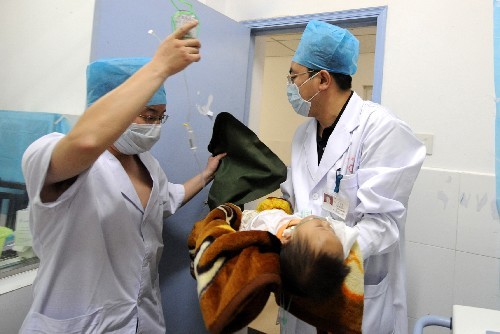Two more Chinese children have died of hand-foot-mouth disease (HFMD), driving the national death toll to 34 -- even as the Health Ministry announced a decline in HFMD cases in the worst-affected city.

Two doctors carry a seriously ill child to the ICU ward of Fuyang Second People's Hospital in Fuyang city, eastern China's Anhui Province on Wednesday, May 7, 2008. [Photo: Xinhua]
Health authorities in east China's Anhui Province on Friday confirmed the two children had died of HFMD triggered by the potentially lethal enterovirus 71 (EV71).
The deaths occurred in Bozhou, northwestern Anhui, and in Hefei, the provincial capital, said Gao Kaiyan, chief of Anhui Provincial Health Department. Gao gave no other details.
The Health Ministry said on Friday that HFMD incidence of in the worst-hit city of Fuyang, also Anhui, was in decline, with discharged patients outnumbering those checking in to hospitals for the first time.
The ministry said on its website that the majority of the serious cases had recovered, with no fatalities for seven consecutive days in Fuyang, which had reported the initial outbreak and 22 deaths.
According to the Guidelines Regarding Prevention and Control of HFMD published on the Ministry of Health website, HFMD can be caused by a host of intestinal viruses, but EV71 and the Coxsackievirus (Cox A16) were the most common.
Both EV71 and Cox A16 can cause HFMD, which usually starts with a slight fever followed by blisters and ulcers in the mouth and rashes on the hands and feet.
Those sickened by EV71 often show serious symptoms. It can also lead to meningitis, encephalitis, pulmonary edema and paralysis in some children. There is no vaccine.
As of Thursday, HFMD sickened 24,934 children on the Chinese mainland, of whom, 34 died. The deaths were reported in six Chinese regions of Anhui, Guangdong, Guangxi, Hainan, Hunan and Zhejiang.
(Xinhua News Agency May 9, 2008)